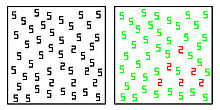On October 15th, 2019, I sent a letter to the Ontario Ministry of Education about Colour Theory.
The problem is the colour theory taught is Red-Yellow-Blue. This isn’t accurate. I received a response from the ministry on November 12th, 2019. I have included what I sent and the reply below.
I confess that I am disappointed. You see, the response wasn’t providing information indicating what I provided was incorrect, only that these are “suggestions for teachers” rather than mandatory. This contradicts my children’s teachers, motivating sending the email to the ministry (in fact they recommended going to the ministry).
When students make mistakes in school, we expect them to learn, improve, and hopefully make new and interesting mistakes instead of the same old ones.
What do we do when the education system is not only making a mistake, but propagates that mistake to others, then fails to remedy the issue when it is pointed out to them?
Original Letter Sent to The Ontario Ministry of Education
(Note: formatting changed to fit as a blog post.)
There has been a recurring issue my kids are facing regarding learning colour theory. Red, yellow, and blue are labelled the primary colours (at least for additive colour theory), such as at: http://www.edu.gov.on.ca/eng/curriculum/elementary/arts18b09curr.pdf. This isn’t correct. When it comes to additive colour theory red, green, and blue are used, which correspond to the peak frequencies of light our colour photoreceptors detect (for typical trichromatics). See http://www.people.vcu.edu/~djbromle/color-theory/color04/sarwar/index.htm for more information. These are the colours used for image reproduction for monitors. The counterpart for subtractive colour theory are cyan, magenta, and yellow (used in colour printers, which also uses a black ink which is more efficient for generating black).
I work in the games industry where colour/image reproduction is relevant and is reflected in internally representation (such as bitmap images which typically use RGB or RGBA (a is alpha for blending with backgrounds) at https://en.wikipedia.org/wiki/BMP_file_format). This isn’t just about games however, this is true for art (relevant in the curriculum for Art for elementary students above): https://www.youtube.com/watch?v=jQqxN8LpGzw.
These don’t fully cover the colour space we can see however and Quora has a great description. What is interesting is there are substantially more interesting ways to combine colour: https://www.quora.com/What-are-the-real-primary-colours.
For some fun/cool/wild information about colour theory:
- The genes the code for the colour photo receptors can become damaged in such a way that only a person expresses only two genes for colour photo receptors resulting in a number of different kinds of colour blindness.
- There are 4 different genes that can code for different colour photo receptors, so some people have all four and can differentiate colours that most people can’t. It is extraordinarily rare.
- Mantis shrimp are the boss of visual fidelity with between 12 and 16 types of photo receptors. They also have a wicked punch (they can break aquarium glass).
- Synesthetes have cross wiring in the brain between senses, in some cases expressing sound or numbers and letters as colours. This can manifest in being able to identify numbers or letters in a field of coloured dots that normally would look like noise.

- While we have a blind spot, other creatures don’t. Eye development can occur along a different path where the nerves attach from the back of the retina instead of coming out of the retina and attaching at the front. For example, the octopus (which also have other interesting properties with their eyes).
- I just learned the other day that while we use muscles to change the shape of our lens for focusing light from different distances on our retina, some creatures move the lens in their eye to achieve the same effect.
Can we get the curriculum updated to reflect this please?
Response from the Ontario Ministry of Education
Dear Brent Scriver,
Thank you for your letter to the Honourable Stephen Lecce, Minister of Education, about revising the Arts curriculum, particularly around the topic of primary colours. I am pleased to respond on behalf of the Minister.
The identification of primary colours as Red-Blue-Yellow appears in the glossary and “Fundamental Concepts” found in the elementary Arts curriculum as well as the glossary of the secondary Arts curriculum. In the Ontario curriculum, examples, “sample questions,” glossary entries, and other items such as “Fundamental Concepts” have been developed and included to assist teachers in the implementation of the curriculum. These additions are meant to model appropriate practice for the grade and are intended as suggestions for teachers rather than as exhaustive or mandatory lists.
The Ontario curriculum is designed and written so that teachers have the flexibility to plan units of study, while taking into account the needs and abilities of the students in their classes. When planning what students will learn, teachers identify the big ideas and skills described in the curriculum expectations, consider the contexts in which students will apply the learning, and determine students’ learning goals.
You may be interested to know that the Grade 10 Science curriculum includes a strand on optics where students have the opportunity to learn about additive and subtractive colours of light based on wave length and frequency which is discussed in some of the materials you provided links to.
If you have any questions or concerns about what your children are learning, we encourage you to have a conversation with your child’s teacher or school principal.
I hope that this information is helpful.
(Note: Removed the responder for privacy)
